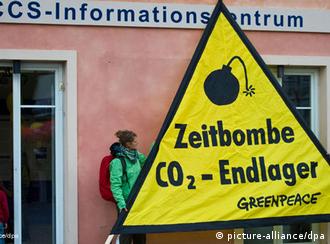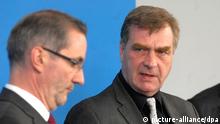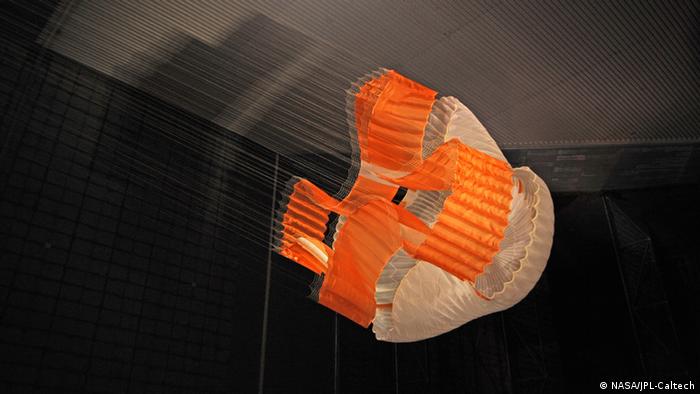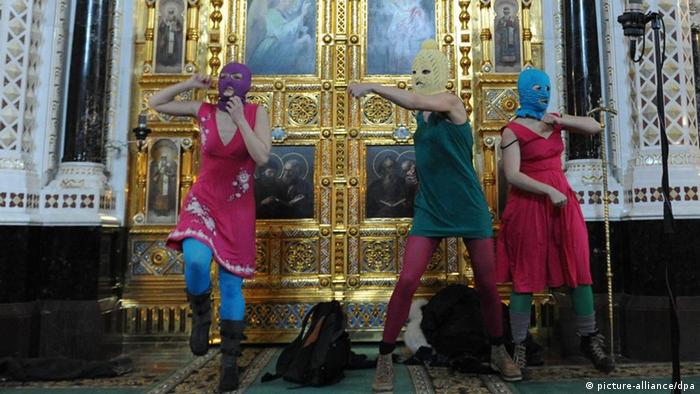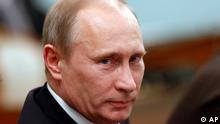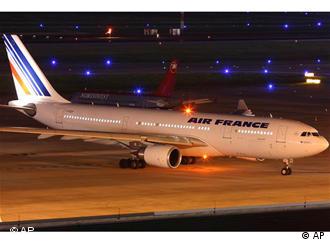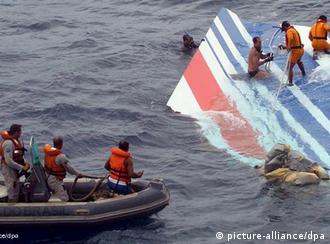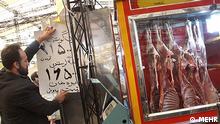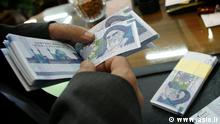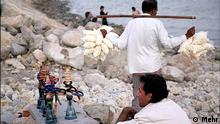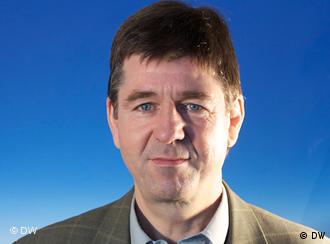From sculptures for dogs to voting rights for strawberries, dOCUMENTA's weird and wacky artworks are grabbing attention. Mid-way into the 100-day show, DW takes another look.
A lot of grass has grown in the past few weeks - not only over all the speculating ahead of this edition of dOCUMENTA, the international exhibition of modern and contemporary art that occurs every five years in Kassel, Germany.
Grass has also grown over the hill of Chinese artist Song Dong's artwork. It's a green hill covered with garden waste, and absolutely magnetizes visitors. Yucca plants are sprouting next to turnip cabbages and bright blue flowered vines are curling around yellow rapeseed. Chance has taken hold of the brush in this work.

Garten waste becomes art
One visitor points to all the "weeds" in distaste, speculating that the artwork is a warning to all potential gardeners. The little signs with "Doing" and "Nothing" printed on them are almost entirely hidden under all the greenery, but seem to confirm her suggestion. However, the artist had a different goal in mind: He wanted to prompt people to be more prudent in their use of resources, even when they appear as worthless as garden waste. The piece addresses one of the central questions this 13th edition of dOCUMENTA poses: how to deal with Planet Earth.
Love, freedom and butterflies
A group of first-graders squeezes up in front of a flowerbed that looks as though a painting of a lawn by Renaissance artist Albrecht Dürer has turned reality. German artist Kristina Buch entitled her work "The Lover," and it's more like an island of plants than anything else.
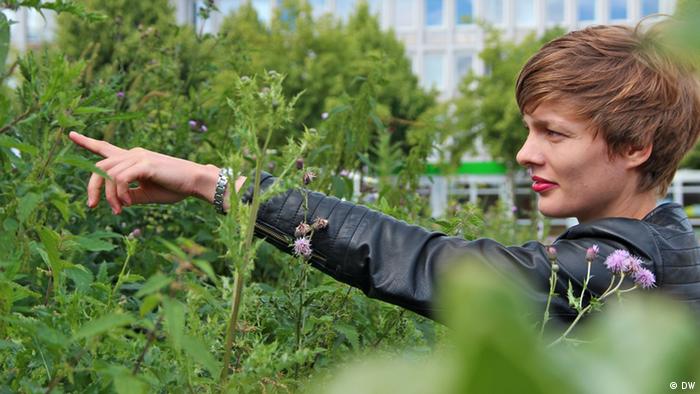
The butterflies have artist Kristina Buch to thank for their sourroundings
Buch has been in Kassel since March, tending the garden and releasing butterflies there daily. The artist, who studied biology and theology in addition to art, sees the piece as an act of commitment to a work that is exceedingly ephemeral, like the brief life of a butterfly. Nonetheless, or precisely because of this, it's an ideal "symbol of freedom." Her garden of butterflies is not flush with the ground, but raised, bringing animals and plants to eye-level and prompting visitors to dispel with their anthropocentric views. A radical change in perspective is just one demand of this edition of dOCUMENTA, which also aims to broaden the scope of art in all directions.
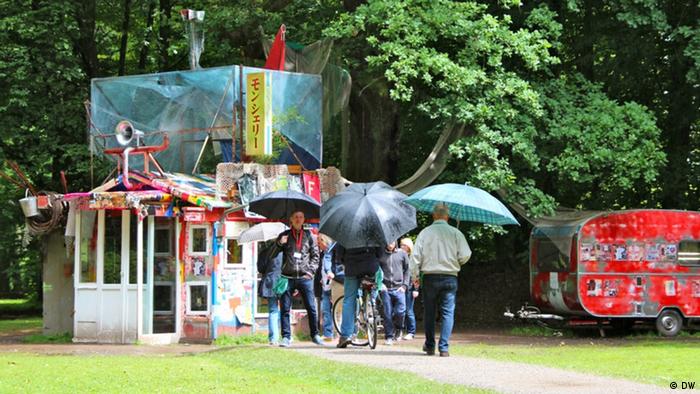
Taking an umbrella to view the artworks is not such a bad idea
Over 160 artists were invited to contribute their works to the show in Kassel, and never have so many been outdoor works. Most of them are located across the majestic 125-hectare (more than 300-acre) Karlsaue Park. In such a pleasure garden, it's not hard to shake one's anxieties about contemporary art. Visitors can stroll along tree-lined paths, losing themselves in the labyrinth of art as if in a Grimm Brothers fairytale.
Spectators of life and death
A feminine figure surrounded by carnivorous plants lies between heaps of compost. Her head is a buzzing bee's nest. A white dog with a pink leg guards the work by French artist Pierre Huyghe entitled "Untilled."

"Untilled" by Pierre Huyghe
It's a spectacle of growth and putrefaction, life and death. What the dog is about, nobody knows. But whatever it means, one thing is clear: this edition of dOCUMENTA is leaving its mark.
Other works are easier to comprehend. Sam Durant constructed a jungle gym that, upon closer inspection, turns out to be gigantic pieces of scaffolding. They are true-to-scale models of execution units significant in US history. There are the gallows used to execute Dakota Native Americans in 1862, and Saddam Hussein in Iraq in 2006.
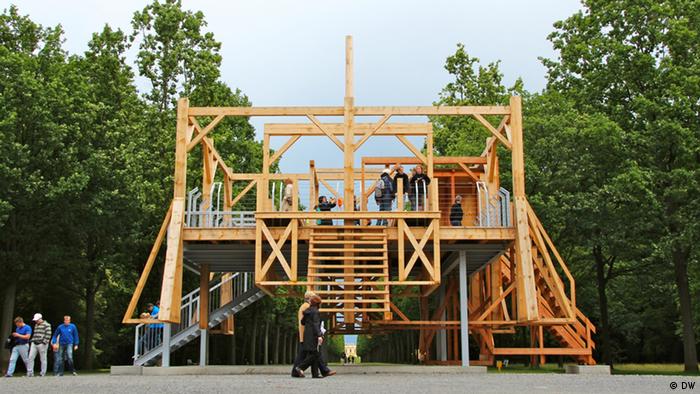
Sam Durant's work is not a jungle gym
The construction stands at the apex of the Karlsaue's main path, and is likewise a symbol of the Absolutist history of the grounds - and the era of guillotines in Europe. It's a strong comment on the death penalty, yet its platform provides a broad view of the English-style park and symbolizes a new perspective on human beings and nature. Durham's scaffold is one of many political artworks in Kassel that also point to the history of the dOCUMENTA location.
The healing power of art
This year's show is vested in the notion of the healing power of art, reflected in its motto "Collapse and Recovery." That can be viewed in terms of political-historical significance, or seen in the context of ill health and recovery.

Pedro Reyes's "Sanatorium"
A line has formed in front of Mexican artist Pedro Reyes's "Sanatorium," where visitors can "admit" themselves and select from 15 different types of therapy, from primal screaming to Fluxus events. Is it a lark, or esoteric thinking?
Reyes would like to treat urban illnesses such as stress, loneliness and fear. Visitors react to his work in a myriad of ways. Some crack jokes, while others reveal all the crooks and crannies of their inner lives to the young art students conducting the sessions.
A shared space
The nicest biotope at dOCUMENTA, though, lies beyond the Karlsaue at the Huguenots house. Once a residence of the bourgeoisie, it was then turned into a hotel before being severely destroyed in the war. Now, however, American installation artist, sculptor and activist Theaster Gates of Chicago has gutted and restored the building, filling it with new life as a residence for Chicago- and Kassel-based participants of employment incentive programs.
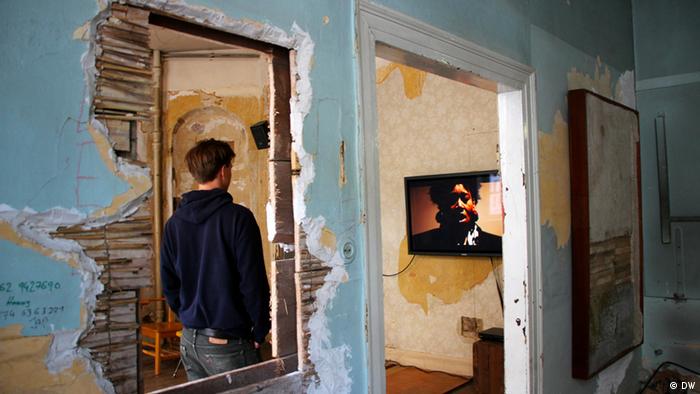
The Huguenots House as a Gesamtkunstwerk
"It could end up being the building with the greatest sex appeal in Kassel," Gates predicted. And it's proven to be true. Cool furniture designs and artworks have sprung forth from materials left over from buildings torn down in Chicago. In this place, the history of the house mixes with that of Black Power. Flat screens flash music performances onto faded floral wallpaper. Concerts take place here regularly, filling the house with music.
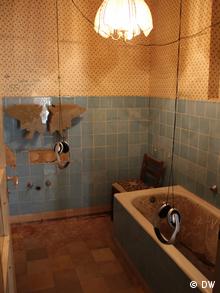
The bathroom is a little less appealing
Two elderly women move to and fro on an avant-garde Hollywood swing. A group of Japanese visitors peeks inside the bedrooms of the building's residents, while the latter sip ice tea in the kitchen. All in all, a place virtually anyone would want to move into - a new form of community where people live, work and play together.
It's just one of the many impressive works to be found at dOCUMENTA this time around, and you'd need days to cover the entire ground. Even then, you may not be able to discern an entirely clear concept of "Collapse and Recovery," but you can relish in the wildly sprawling cosmos of artistic expression. dOCUMENTA is sometimes esoteric, often political, but always linked to the demand that we ponder things - a demand visitors readily fulfill.
Author: Ulrike Sommer / als
Editor: Kate Bowen
Editor: Kate Bowen

